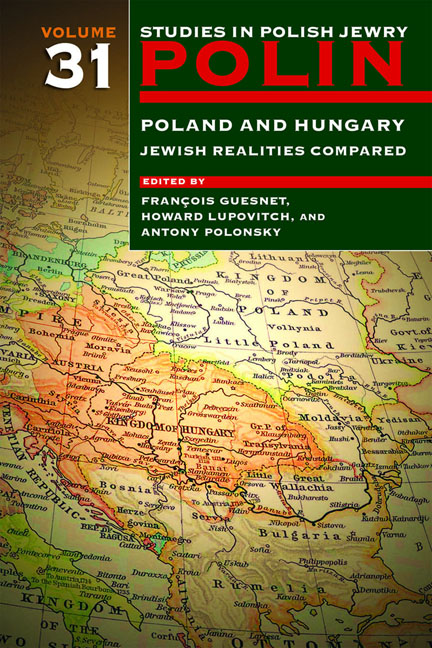Book contents
- Frontmatter
- Dedication
- Editors and Advisers
- Preface
- Polin
- Polin: Studies in Polish Jewry
- Contents
- Note on Place Names
- Note on Transliteration
- Part I POLAND AND HUNGARY: JEWISH REALITIES COMPARED
- JEWISH ACCULTURATION AND INTEGRATION
- JEWISH RELIGIOUS LIFE
- JEWS IN POPULAR CULTURE
- THE INTERWAR YEARS
- THE HOLOCAUST AND ITS AFTERMATH
- PERSONAL REFLECTIONS
- Part II NEW VIEWS
- Part III OBITUARIES
- Notes on the Contributors
- Index
Polish ‘Progressive’ Judaism and Hungarian Neolog Judaism: A Comparison
- Frontmatter
- Dedication
- Editors and Advisers
- Preface
- Polin
- Polin: Studies in Polish Jewry
- Contents
- Note on Place Names
- Note on Transliteration
- Part I POLAND AND HUNGARY: JEWISH REALITIES COMPARED
- JEWISH ACCULTURATION AND INTEGRATION
- JEWISH RELIGIOUS LIFE
- JEWS IN POPULAR CULTURE
- THE INTERWAR YEARS
- THE HOLOCAUST AND ITS AFTERMATH
- PERSONAL REFLECTIONS
- Part II NEW VIEWS
- Part III OBITUARIES
- Notes on the Contributors
- Index
Summary
For all their differences, particularly the failure of Polish Jewry to assimilate and the overwhelmingly successful assimilation of Hungarian Jewry, both Polish and Hungarian Jews found themselves in similar circumstances during the interwar period. Intense antisemitism, beginning in the 1880s, came to a full boil in the aftermath of the First World War. Acculturated or not, both groups had been reduced to pariah status by the outbreak of the Second World War. Despite the yawning chasm between the self-identities of Jews in Poland and those of Jews in Hungary, attempts at moderate religious reform, particularly in liturgy and synagogue practice, were successful in both countries, albeit on a much different scale. Religious reform in the Polish lands made few inroads among most of the Jewish population, unlike Hungarian Jewry's moderate reforms in the so-called Neolog movement. There was a small but very significant number of Polish Jews who called themselves postępowi, ‘Progressives’. A comparison of liturgical changes in the language of the Progressive and Neolog prayer books reveals that Polish Progressive and Hungarian Neolog Judaism were in many ways alike. The most important similarity was the adaptation of the moderate Vienna rite (Wiener Ritus) of Isak Noa Mannheimer, while the second was use of the organ or other instruments which were traditionally forbidden.
RADICAL OR MODERATE CHANGE
It was in the private prayer rooms of the very wealthy at the beginning of the nineteenth century that some form of streamlined liturgy came into being. This was true of the Flatau home in Warsaw, for example, but this was a private place of worship and not a synagogue proper. On Shavuot 14 June 1815 Jacob Herz Beer, father of the composer Giacomo Meyerbeer, Ruben Samuel Gumpertz, and Daniel Itzig opened a private prayer association in Itzig's residence in Berlin which was attended by 400 people. The first really successful reformed prayer book came from Hamburg in 1817/18 and became a cause celebre. The first Reform temple, that is, a formal venue for public worship, opened in Hamburg in 1818 as the New Israelite Temple Society with a congregation of sixty-five families.
- Type
- Chapter
- Information
- Polin: Studies in Polish Jewry Volume 31Poland and Hungary: Jewish Realities Compared, pp. 225 - 242Publisher: Liverpool University PressPrint publication year: 2018



